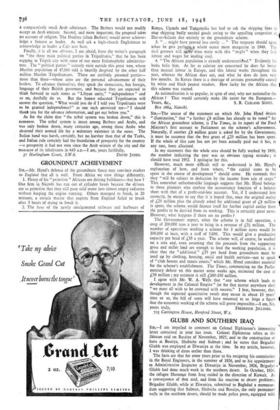Sut,—The source of the statement on which Mr. John Hynd
desires "illumination," that "a further £8 million has already to be voted" for the African groundnut scheme, is The Times, in its report of the Food Minister's first account to Parliament on the scheme's achievements. Naturally, if another £8 million grant is asked for by the Government, it must be assumed that the first grant of £25 million has been spent. If the whole of this sum has not yet been actually paid out it has, at any rate, been alloCated.
In my statement that the whole area should be fully worked by 1950, the number indicating the year was an obvious typing mistake ; it should have read 1952. I apologise for this.
However, much more difficult still to understand is Mr. Hynd's explanation of how, and from where, " the capital sums to be spent in the course of development " should come. He contends that they " will be subject to deduction by the income from sale of crops." This somewhat unbusinesslike language suggests that. Mr. Hynd belongs to those planners who confuse the accountancy function of a balance sheet with that of a profit-and-loss account. Yet, if I understand him correctly, he means to say that it is hoped that, once the original outlay of £25 million plus the already asked for additional grant of £8 million is spent, the scheme .would finance itself -for further capital outlay from the profits to be derived from its working. This is certainly great news. However, what happens if there are no profits ? The Covernment expect, when the scheme is in full operation, a crop of 200,000 tons a year to bring in a revenue of £34 million. The number of operatives working a scheme for 3 million acres would be 100,000 at least, with a staff of 5,000. This would give a productive capacity per head of £35 a year. The scheme will, of course, be worked on a rota and, even assuming that the proceeds from the supporting grass and millet land are enough to feed the working population, it is clear that the "additional" £35 per head from groundnuts must be used up by clothing, housing, social and health services—not to speak 1 of "club houses and tennis courts," which Mr. Hynd considers essential for the scheme's establishment. The Times, commenting on the Parlia- mentary debate on this matter some weeks ago, estimated the cost at £50 million ; my estimate is still £100-150 million.
I agree with Mr. W. A. Wells that "any scheme which leads to development in the Colonial Empire " (or for that matter anywhere else) "we must all wish to be crowned with success." I fear, however, that, though the expected quantitative result may ensue in about 15 years' time or so, the bill of costs will have mounted to so large a figure that the economic working of the scheme will prove impossible.—I am, Sir,
1
yours truly, FREDERICK JELLINEK. 7os Carrington House, Hertford Street, W.i.


































 Previous page
Previous page